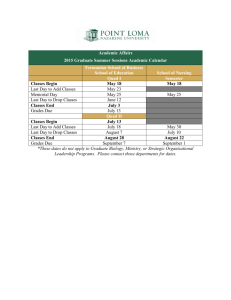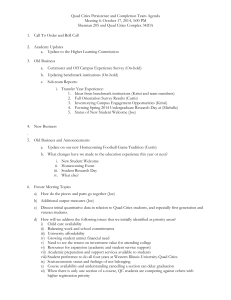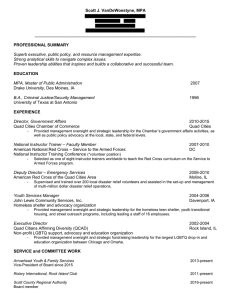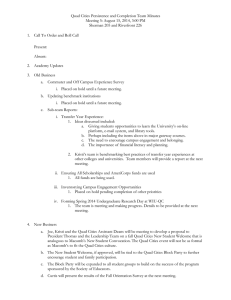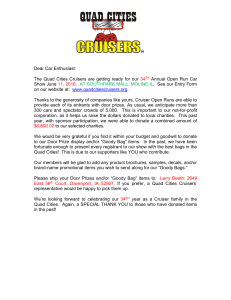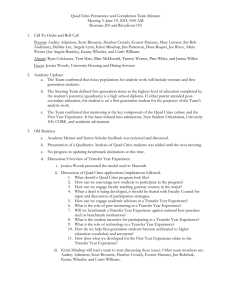ITU Advance Level Strategic Training on Cost Modeling and Pricing for Quad‐Play / Next Generation Access (NGA) for English‐speaking
advertisement
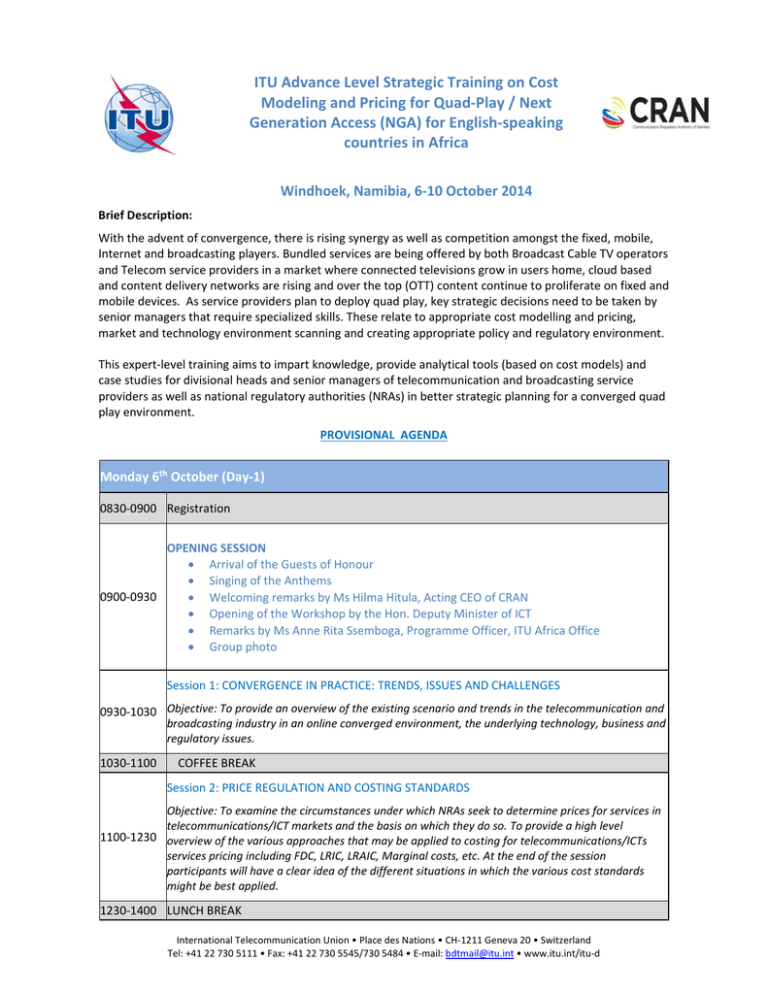
ITU Advance Level Strategic Training on Cost Modeling and Pricing for Quad‐Play / Next Generation Access (NGA) for English‐speaking countries in Africa Windhoek, Namibia, 6‐10 October 2014 Brief Description: With the advent of convergence, there is rising synergy as well as competition amongst the fixed, mobile, Internet and broadcasting players. Bundled services are being offered by both Broadcast Cable TV operators and Telecom service providers in a market where connected televisions grow in users home, cloud based and content delivery networks are rising and over the top (OTT) content continue to proliferate on fixed and mobile devices. As service providers plan to deploy quad play, key strategic decisions need to be taken by senior managers that require specialized skills. These relate to appropriate cost modelling and pricing, market and technology environment scanning and creating appropriate policy and regulatory environment. This expert‐level training aims to impart knowledge, provide analytical tools (based on cost models) and case studies for divisional heads and senior managers of telecommunication and broadcasting service providers as well as national regulatory authorities (NRAs) in better strategic planning for a converged quad play environment. PROVISIONAL AGENDA Monday 6th October (Day‐1) 0830‐0900 Registration OPENING SESSION Arrival of the Guests of Honour Singing of the Anthems 0900‐0930 Welcoming remarks by Ms Hilma Hitula, Acting CEO of CRAN Opening of the Workshop by the Hon. Deputy Minister of ICT Remarks by Ms Anne Rita Ssemboga, Programme Officer, ITU Africa Office Group photo Session 1: CONVERGENCE IN PRACTICE: TRENDS, ISSUES AND CHALLENGES 0930‐1030 Objective: To provide an overview of the existing scenario and trends in the telecommunication and broadcasting industry in an online converged environment, the underlying technology, business and regulatory issues. 1030‐1100 COFFEE BREAK Session 2: PRICE REGULATION AND COSTING STANDARDS Objective: To examine the circumstances under which NRAs seek to determine prices for services in telecommunications/ICT markets and the basis on which they do so. To provide a high level 1100‐1230 overview of the various approaches that may be applied to costing for telecommunications/ICTs services pricing including FDC, LRIC, LRAIC, Marginal costs, etc. At the end of the session participants will have a clear idea of the different situations in which the various cost standards might be best applied. 1230‐1400 LUNCH BREAK International Telecommunication Union • Place des Nations • CH‐1211 Geneva 20 • Switzerland Tel: +41 22 730 5111 • Fax: +41 22 730 5545/730 5484 • E‐mail: bdtmail@itu.int • www.itu.int/itu‐d Session 3A: PRACTICAL EXERCISE ON QUAD‐PLAY COSTING USING NEXT GENERATION ACCESS NETWORK COST MODEL 1400‐1530 Objective: A hypothetical but realistic scenario in which an over‐the‐top service provider seeks access to an incumbent’s broadband access network. To assist the negotiations participants have to work with the ITU’s NGA Training Cost Model. In this first part the scenario is explained and the cost model is introduced. 1530‐1545 COFFEE BREAK Session 3B: PRACTICAL EXERCISE ON QUAD‐PLAY COSTING USING NEXT‐GENERATION ACCESS NETWORK COST MODEL Objective: A hypothetical but realistic scenario in which an over‐the‐top service provider seeks 1545‐1700 access to an incumbent’s broadband access network. To assist the negotiations participants have to work with the ITU’s NGA Training Cost Model. In this second part participants split into teams in which they manipulate the cost model and prepare their negotiating positions. Tuesday 7th October (Day‐2) Session 3C: PRACTICAL EXERCISE ON QUAD‐PLAY COSTING USING NEXT GENERATION ACCESS NETWORK COST MODEL 0900‐1030 Objective: A hypothetical but realistic scenario in which an over‐the‐top service provider seeks access to an incumbent’s broadband access network. To assist the negotiations participants have to work with the ITU’s NGA Training Cost Model. In this third and final part the negotiations are conducted and decisions reached; learning points are then discussed in plenary session. 1030‐1100 COFFEE BREAK Session 4: NGA AND NGN INTERCONNECTION TRENDS Objective: To examine the extent to which regulation of Next generation Networks, including Next 1100‐1230 Generation Access, is necessary and sufficient to achieve national broadband policy goals. To illustrate the main current and emerging issues involved in establishing interconnection charges for NGN through a review of international experience and practice. 1230‐1400 LUNCH BREAK Session 5A: PRACTICAL EXERCISE ON QUAD‐PLAY NEGOTIATION 1400‐1530 Objective: A hypothetical but realistic scenario in which an over‐the‐top service provider seeks to negotiate a quad‐play offer with non‐dominant fixed and mobile operators. In this first part the parties prepare their offers based on defined commercial objectives and business modelling. 1530‐1545 COFFEE BREAK Session 5B: PRACTICAL EXERCISE ON QUAD‐PLAY NEGOTIATION Objective: A hypothetical but realistic scenario in which an over‐the‐top service provider seeks to negotiate a quad‐play offer with non‐dominant fixed and mobile operators. In 1545‐1700 this second part the negotiations are conducted and presentations made to the industry regulator seeking regulatory approval and/or mediation. Wednesday 8th October (Day‐3) Session 6: TRENDS IN NGA and NGN REGULATION Objective: To examine the extent to which regulation of Next Generation Networks, 0900‐1030 including Next Generation Access, is necessary and sufficient to achieve national broadband policy goals. To illustrate the main current and emerging issues involved in establishing interconnection charges for NGN through a review of international experience and practice. 1030‐1100 COFFEE BREAK Session 7A: PRACTICAL EXERCISE ON QUAD‐PLAY COSTING USING NEXT GENERATION CORE NETWORK COST MODEL 1100‐1230 Objective: A hypothetical but realistic scenario in which service providers seek to acquire regulatory approval for a quad‐play offer by demonstrating that it is not anti‐competitive because it covers all relevant network costs. In this first part the scenario is explained and the ITU NGN training cost model is introduced. 1230‐1400 LUNCH BREAK Session 7B: PRACTICAL EXERCISE ON QUAD‐PLAY COSTING USING NEXT GENERATION CORE NETWORK COST MODEL 1400‐1530 Objective: A hypothetical but realistic scenario in which service providers seek to acquire regulatory approval for a quad‐play offer by demonstrating that it is not anti‐competitive because it covers all relevant network costs. In this second part the participants split into teams in which they manipulate the cost model and prepare their negotiating positions 1530‐1545 COFFEE BREAK Session 7C: PRACTICAL EXERCISE ON QUAD‐PLAY COSTING USING NEXT GENERATION CORE NETWORK COST MODEL 1545‐1700 Objective: A hypothetical but realistic scenario in which service providers seek to acquire regulatory approval for a quad‐play offer by demonstrating that it is not anti‐competitive because it covers all relevant network costs. In this third part participants make their presentations to the regulator, after which lessons are learned in plenary session. Thursday 9th October (Day‐4) Session 8: WEIGHTED AVERAGE COST OF CAPITAL – THEORY AND PRACTICE 0900‐1030 Objective: To explain the theory behind the various elements those from the Weighted Average Cost of Capital (WACC) and detail the methodologies for estimating them in practice. 1030‐1100 COFFEE BREAK Session 9A: PRACTICAL EXERCISE ON QUAD‐PLAY COSTING USING MOBILE NETWORK COST MODEL 1100‐1230 Objective: A hypothetical but realistic scenario in which a mobile network operator seeks regulatory approval for a quad‐play offer by demonstrating that it is not anti‐competitive because it covers all relevant network costs. In this first part the scenario is explained and the ITU mobile training cost model is introduced. 1230‐1400 LUNCH BREAK Session 9B: PRACTICAL EXERCISE ON QUAD‐PLAY COSTING USING MOBILE NETWORK COST MODEL 1400‐1530 Objective: A hypothetical but realistic scenario in which a mobile network operator seeks regulatory approval for a quad‐play offer by demonstrating that it is not anti‐competitive because it covers all relevant network costs. In this first part participants prepare their case with reference to ITU’s NGN and mobile network training cost models. 1530‐1545 COFFEE BREAK Session 9C: PRACTICAL EXERCISE ON QUAD‐PLAY COSTING USING MOBILE NETWORK COST MODEL 1545‐1700 Objective: A hypothetical but realistic scenario in which a mobile network operator seeks regulatory approval for a quad‐play offer by demonstrating that it is not anti‐competitive because it covers all relevant network costs. In this final part participants make their presentations to the regulator, after which lessons are learned in plenary session. Friday 10th October (Day‐5) Session 10: THE QUAD‐PLAY ECOSYSTEM 0900‐1030 Objective: To understand the business environment of quad play, its revenue drivers and ecosystem, including an industry case study. What are the main drivers and constraints on quad‐play success, and where are the likely competition issues likely to arise? 1030‐1100 COFFEE BREAK Session 11: APPROPRIATE EX‐POST RESPONSES TO BROADBAND MARKET FAILURES 1100‐1230 Objective: Interactive case studies based on international experience and practice that demonstrate how to respond to anti‐competitive practice in broadband and quad‐play markets. 1230 LUNCH AND CLOSE OF TRAINING
